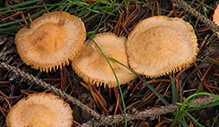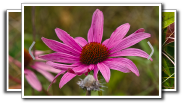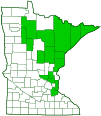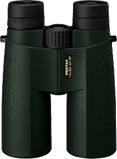Earthy Powdercap
(Cystoderma amianthinum)
Conservation • Description • Habitat • Ecology • Distribution • Taxonomy
Conservation Status |
|||
| IUCN Red List | not listed |
||
| NatureServe | not listed |
||
| Minnesota | not listed |
||
Description
Earthy Powdercap is a common and widespread, small to medium-sized, gilled mushroom. It occurs in Europe, Asia, North America, and southern Australia. It occurs throughout most of the northern United States and southern Canada, but it is absent from the Great Plains and the Great Basin. It is found in late summer and fall; alone, scattered, or in groups but not clustered (gregarious); in coniferous and mixed woodlands. It grows on the ground, usually on moss but also on fallen leaves in mixed woodlands and on needle carpets in coniferous woodlands. It obtains its nutrients from decayed organic matter (saprobic).
When it first appears, the cap is convex, broadly cone-shaped, or bell-shaped. The color is variable, and different forms have been described on the basis of young cap color. The typical form is yellow to yellowish brown or orangish brown, one form is olive colored, and one form is white. The mature cap is broadly convex, broadly bell-shaped, or nearly flat. The surface is covered with dry, mealy granules, which are often washed off by rain, and it may be conspicuously radially wrinkled, slightly wrinkled, or smooth. The margin is often hung with remnants of the partial veil.
The gills are closely spaced or crowded, and they may be narrowly or broadly attached to the stalk. They are white or cream-colored at first, becoming yellowish or yellowish orange with age.
The stalk is 1″ to 2¾″ (2.5 to 7.0 cm) long and ⅛″ to 5⁄16″ (3 to 8 mm) thick. It may be the same size from top to bottom or slightly enlarged toward the base. There is a flimsy ring at first, a remnant of the partial veil, but this often fragments or completely disappears with age. Above the ring the stalk is pale or whitish and smooth. Below the ring the stalk is colored like the cap and is sheathed with mealy granules. Shielded by the cap above, the granules are not washed off by rain.
The flesh is thin and whitish. It is not poisonous, but eating is not recommended because it can easily be confused with the deadly poisonous Lepiota castanae.
The spore print is white.
Similar Species
Habitat and Hosts
Coniferous and mixed woodlands
Ecology
Season
Late summer and fall
Distribution |
||
|
Sources Biodiversity occurrence data published by: Minnesota Biodiversity Atlas (accessed through the Minnesota Biodiversity Atlas Portal, bellatlas.umn.edu, 11/28/2025). |
|
| 11/28/2025 | ||
Occurrence |
||
|
||
Taxonomy
Kingdom
Fungi (Fungi)
Subkingdom
Dikarya
Phylum
Basidiomycota (Basidiomycete Fungi)
Subphylum
Agaricomycotina (Higher Basidiomycetes)
Class
Agaricomycetes (Mushrooms, Bracket Fungi, Puffballs, and Allies)
Subclass
Agaricomycetidae
Order
Agaricales (Common Gilled Mushrooms and Allies)
Suborder
Agaricineae
Family
Squamanitaceae
Genus
Cystoderma (Powdercaps)
Subordinate Taxa
Several forms and varieties have been described based on the color of the cap, the amount of wrinkling on the cap, and the shape of the spores. Sources vary on the number of names and the rank of the subordinate taxa that are recognized. Two varieties have been separated as a distinct species by some sources. GBIF recognizes no subordinate taxa and treats all of the remaining names as synonyms.
Earthy Powdercap (Cystoderma amianthinum f. album) ![]()
Earthy Powdercap (Cystoderma amianthinum var. amianthinum) ![]()
Earthy Powdercap (Cystoderma amianthinum var. rugosoreticulatum) ![]()
Synonyms
Agaricus amianthinus
Agaricus amianthinus var. broadwoodiae
Agaricus granulosus var. amianthinum
Agaricus granulosus var. amianthinus
Agaricus granulosus x amianthinus
Agaricus ochraceus
Agaricus rugosoreticulatus
Armillaria amianthina
Armillaria rugosoreticulata
Cystoderma amianthinum f. album
Cystoderma amianthinum f. olivaceum
Cystoderma amianthinum f. rugosoreticulatum
Cystoderma amianthinum f. rugulosoreticulatum
Cystoderma amianthinum ssp. album
Cystoderma amianthinum ssp. rugosoreticulatum
Cystoderma amianthinum ssp. rugulosoreticulatum
Cystoderma amianthinum var. album
Cystoderma amianthinum var. rugosoreticulatum
Cystoderma longisporum f. rugosoreticulatum
Cystoderma longisporum ssp. rugosoreticulatum
Cystoderma rugosoreticulatum
Cystoderma sublongisporum
Lepiota amianthina
Lepiota amianthina ssp. alba
Lepiota amianthina var. alba
Lepiota amianthina var. broadwoodiae
Lepiota amianthina var. broadwoodiae
Lepiota amianthina var. evae
Lepiota granulosa ssp. amianthina
Lepiota granulosa var. amianthina
Lepiota granulosa var. ochracea
Lepiota rugosoreticulata
Common Names
Earthy Powdercap
Unspotted Cystoderma
Glossary
Partial veil
A protective covering over the gills or pores of a developing mushroom. At maturity it disappears, collapses into a ring around the stem, or wears away into a cobwebby covering and ring zone.
Saprobic
A term often used for saprotrophic fungi. Referring to fungi that obtain their nutrients from decayed organic matter.
Visitor Photos
Share your photo of this fungus.
This button not working for you?
Simply email us at info@MinnesotaSeasons.com.
Attach one or more photos and, if you like, a caption.
Bobbi Johnson |
 |
MinnesotaSeasons.com Photos
|

Slideshows
Cystoderma amianthinum
Mushrooms Fungi
Cystoderma amianthinum
Domenico Memoli

Visitor Videos
Share your video of this fungus.
This button not working for you?
Simply email us at info@MinnesotaSeasons.com.
Attach a video, a YouTube link, or a cloud storage link.
Other Videos
Red mushroom
Ajaydeep Maurya



